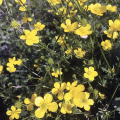Feeding Fish
Feeding Fish
You do not normally have to feed fish in a healthy bream and bass pond to produce good crops of fish. Natural food organisms are typically abundant enough to feed fish. However, you can increase growth of bream with a supplemental feeding program using a catfish floating feed (about 28 percent protein).
Bluegill readily accept feed and can be attracted quickly to feeding areas. Always feed small ponds stocked at high density with channel catfish or hybrid sunfish to maximize fish growth. Not feeding gives poor results. Here are some points to consider about feeding:
- Feed at the same time and place each day.
- Use floating feed, with a pellet size small enough to be easily eaten.
- Never feed more than the fish will eat in 5 to 10 minutes. Keep in mind that uneaten feed may pollute the water.
- If fish quit eating, stop feeding for a few days. Watch for signs of disease.
- Do not feed in very cold or very hot water.
- Reduce the feeding rate as winter approaches to about one-fourth of the feed rate of the previous summer.
- Automatic feeders give good growth results where small ponds are unattended for long periods.
- Do not try to feed fish up to large sizes without some harvest to reduce the number of fish. Otherwise, crowded large fish may become diseased and die.
Following these simple rules will provide good growth rates while minimizing the risks of deteriorating water quality.
Publications
News
Whether you have a large lawn, field, or pasture, you’ve probably had to deal with pesky weeds.
BILOXI, Miss. -- The Southeast has some of the most commercially and recreationally valuable fisheries in the United States.
Success Stories
Billy Mitchell spent his childhood summers in the water and has lived at Pelahatchie Bay for more than three decades, so his dedication to protecting water resources now almost makes too much sense.







